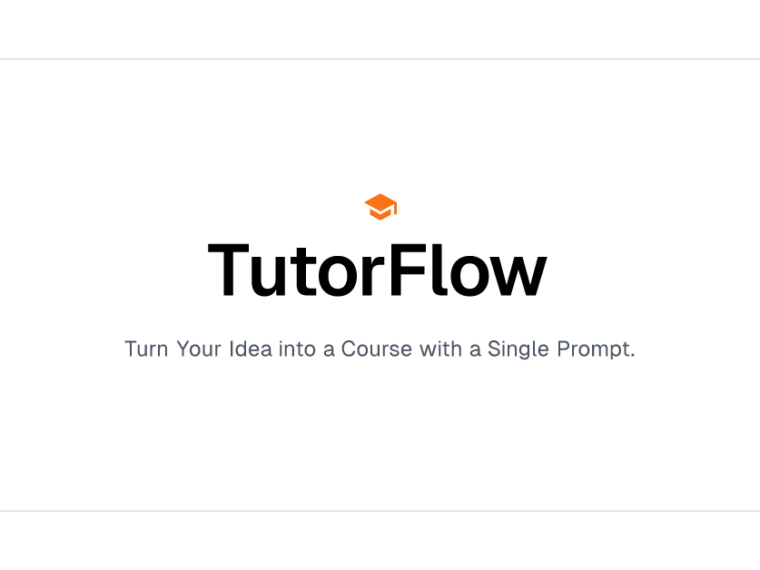The traditional path to creating an online course is paved with sweat, time, and technical hurdles. Educators and subject-matter experts face weeks of content structuring, slide design, quiz creation, and platform configuration. But what if you could transform a single idea into a polished, interactive course in less time than it takes to brew coffee? Enter TutorFlow – the AI-powered platform revolutionizing course creation by turning simple prompts into comprehensive learning experiences for subjects like Python, AI, and Physics.
The Agony of Traditional Course Development
Creating a course from scratch demands superhuman effort:
- Content Curation: Sourcing materials, writing scripts, designing visuals.
- Structural Engineering: Organizing modules, sequencing lessons, balancing theory/practice.
- Assessment Design: Crafting quizzes, coding exercises, and projects.
- Technical Assembly: Uploading to LMS platforms, troubleshooting formatting.
A 4-week Python course could take months to build. TutorFlow obliterates this bottleneck.
TutorFlow’s Alchemy: How “Prompt → Course” Actually Works
Imagine typing:
*“Create a 6-module introductory course on Quantum Physics for high school students, with interactive simulations and weekly quizzes.”*
TutorFlow’s AI engine processes this in three phases:
Phase 1: Semantic Architecture
- Analyzes keywords (“Quantum Physics,” “high school,” “interactive simulations”).
- Maps curriculum to foundational→advanced concepts (e.g., Wave-Particle Duality → Schrödinger’s Equation).
- Structures modules with learning objectives and estimated duration.
Phase 2: Content Generation & Curation
- Core Lessons: Drafts concise explanations, analogies, and real-world examples.
- Multimedia Integration: Recommends/embeds simulations (e.g., double-slit experiment tools).
- Practice Ecosystems: Auto-generates quizzes, Python coding challenges (for calc-based problems), and discussion prompts.
Phase 3: Classroom-Ready Packaging
- Formats content into a responsive, navigable course interface.
- Enables one-click publishing to web, mobile, or LMS.
- Provides analytics dashboards (engagement, quiz performance).
Result: A ready-to-teach course emerges in 20-60 seconds.
Real-World Use Cases: Python, AI & Physics in Action
1. Coding Instructor → Python Course in 35 Seconds
Prompt:
*“Project-based Python course for beginners: 5 modules, teach lists, functions, APIs, and a capstone weather app project. Include debugging exercises.”*
TutorFlow Delivers:
- Module 3: “Functions & Error Handling” with embedded code editor + sample buggy code.
- Capstone: Step-by-step instructions to build a city weather fetcher using OpenWeather API.
- Auto-graded exercises validating code output.
2. Data Scientist → Practical AI Course in 42 Seconds
Prompt:
“Ethical AI applications for business leaders: 4 modules, case studies on bias detection, model interpretability, and ROI frameworks.”
TutorFlow Delivers:
- Module 2: “Bias in Training Data” with real dataset analysis activity.
- Interactive flowchart: “Should You Automate This Decision?”
- Self-assessment quiz on AI ethics principles (e.g., EU AI Act).
3. Physics Professor → Modern Physics Lab in 28 Seconds
Prompt:
“Special relativity concepts for engineering students: visualizations of time dilation, length contraction. Derive E=mc² mathematically.”
TutorFlow Delivers:
- Interactive Minkowski diagram tool with sliders for velocity (v/c).
- Animated derivation of Lorentz transformations.
- Formula practice problems with instant feedback.
Why This Changes Everything for Education
- Democratization: Subject experts without instructional design degrees can share knowledge.
- Iteration Speed: Test course ideas instantly → refine based on learner feedback.
- Cost Slashed: No need for developers, instructional designers, or video editors.
- Personalization: Generate alternate versions (e.g., “simplify for 9th graders”) in seconds.
Behind the Scenes: The Tech Powering TutorFlow
TutorFlow leverages a layered AI stack:
- LLM Foundation Models (GPT-4, Claude 3) for content coherence.
- Knowledge Graph Integration: Ensures scientific/mathematical accuracy (e.g., correct Python syntax, physics formulas).
- Pedagogical Algorithms: Structures content using Bloom’s Taxonomy (knowledge → application → analysis).
- Adaptive Assessment Engine: Generates dynamic questions based on difficulty curves.
The Future: Beyond the 60-Second Course
TutorFlow’s roadmap hints at even greater disruption:
- AI Tutors: On-demand assistants answering student questions within courses.
- Multimodal Expansion: Auto-generate explanatory diagrams/sketches from text.
- Credentialing: Issue verifiable certificates upon course completion.
From Idea to Impact – Instantly
TutorFlow isn’t just a tool—it’s an educational paradigm shift. By compressing months of labor into seconds, it frees educators to focus on what truly matters: inspiring students, refining pedagogy, and advancing human understanding. Whether you’re explaining Python loops, AI ethics, or the fabric of spacetime, your expertise can now scale at the speed of thought.
The classroom of the future isn’t just digital—it’s instant.
Ready to turn your knowledge into impact?
Try TutorFlow today – your first course is 60 seconds away.
Explore TutorFlow Courses →




